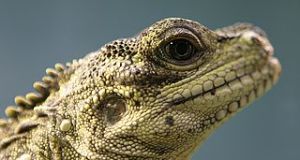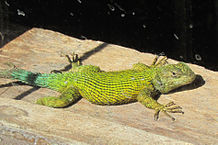Click:The Green Anole (Anolis carolinensis carolinensis) in the Wild and Captivity; – Natural History – Part 1 to read the first part of this article.
Introduced Anoles
 The green anole is the only anole native to the USA, but eight other species, originating as escaped or released pets, have established breeding populations here. The most common and widespread is the brown anole (A. sagrei), now found throughout Florida and in southern Georgia, Alabama, Louisiana, Texas and Hawaii. In many areas it is now more commonly encountered than the green anole.
The green anole is the only anole native to the USA, but eight other species, originating as escaped or released pets, have established breeding populations here. The most common and widespread is the brown anole (A. sagrei), now found throughout Florida and in southern Georgia, Alabama, Louisiana, Texas and Hawaii. In many areas it is now more commonly encountered than the green anole.
The knight anole (A. equestris), bark anole (A. distichus), large-headed anole (A. cybotes), Hispaniolan anole (A. chlorocyanus), Cuban green anole (A. porcatus) and Jamaican giant anole (A. gormani) are limited to the vicinity of Miami and Miami-Dade County at this time.
Ill Fated Pets
Green anoles were sold by the millions at carnivals, circuses and through the mail in the 1960’s and early 70’s. Termed “chameleons” due to their color changing abilities, most were fed “sugar water” and expired in short order.
Color Change – not as obvious as it seems
Color change in the green anole has little to do with the background upon which the animal rests (although the colors it exhibits are usually cryptic). Cool or stressed anoles are brown in color, while warm, resting individuals are pale green and warm, active animals are bright green. Anoles involved in aggressive displays develop a black patch behind the eyes.
Unique Climbing Aids
Green anoles are assisted in climbing by transverse lamellae on the bottoms of the toes and feet. These thin structures are divided by thousands of grooves, and provide excellent traction against tiny irregularities in the surface upon which the lizard is moving. Utilizing the lamellae, anoles can even grip dirt particles lodged on glass, and hence climb window panes and aquarium sides easily.
Cold Tolerance and its Conservation Implications
Research has demonstrated that anoles from south Florida lack the cold tolerance exhibited by those in north Florida, and could not survive the winters there. Information such as this is vital in planning reintroduction and captive breeding programs for animals with large ranges. Inter-breeding animals that originate in widely different parts of their range can have disastrous consequences, despite the fact that they are of the same species.
In one case, ibex (mountain dwelling goats) from several European countries were released in the Pyrenees Mountains, to bolster the local population. The animals reproduced, but the offspring resulting from the crossing of native and non-native ibex were genetically programmed to give birth in mid-winter, and the population eventually became extinct.
An interesting summary of research being conducted on free-living green anoles by students at UT Knoxville is posted at:
http://eeb.bio.utk.edu/echternacht.asp
 That Reptile Blog – Reptile, Amphibian and Exotic Pet Care and Information
That Reptile Blog – Reptile, Amphibian and Exotic Pet Care and Information




is it possible these are in Jamaica?
Hello, Frank Indiviglio here.
Thanks for your interest in our blog. They have not been officially recorded on Jamaica, but I would not be surprised. They have been introduced to Cuba, Hawaii, Japan and elsewhere. However, Jamaica does have several native anoles that resemble this species and are hard to distinguish from it by appearance alone.
Please let me know if you need any further information. Good luck, enjoy and please keep me posted.
Best regards, Frank Indiviglio.
thanks for getting back! Well, cuba is just next door, possible from there? Or i guess like you said, they are hard to distinguish from one another. Can i send you a pic?
Hello, Frank Indiviglio here.
Thanks for the feedback; yes, possible from Cuba; people transport them as pets, also eggs and juveniles are tiny, travel in soil with plants, may even raft over on debris during storms. You can send a photo, positive ID may be difficult w/o scale counts, etc. but would be interested to take a look; please email to findiviglio@thatpetplace.com thanks.
Best regards, Frank Indiviglio.
I just bought three anoles and I noticed that one of them is missing a tail and a foot. Well, not missing. They’re there. Just burned and shriveled… They just got home and I haven’t done anything that possibly could have done that. Is there something I should do to help it out or something? It can’t climb like the other two, but other than that it seems relatively content.
Hello Amber,
I recently had a cornea transplant and so I might be excused for not noticing such things, but…
Just Teasing – as long as there’s no infection, and it doesn’t sound as though there is, the animal should be fine; it would be a quick meal for a snake etc. in the wild, but pets get along well. The tail will likely grow back, partially. Be sure to feed them properly, and provide the right temps and UVB exposure…let me know if you need more info, enjoy, Frank
I’m worried about one of the other anoles now. Well, all of them really, but one in particular. None of them are eating. We’ve tried crickets, worms we found outside, and then now we just tried waxworms. (Would have tried calci-worms too, but when we opened that there were a couple wasps on the bottom of the lid. No thank you.) We’ve tried just putting the food in the cage with them, and we’ve tried taking the anoles out and holding it in front of them. They just refuse to even attempt eating. The one I’m worried about most right now is looking almost anorexic. http://i1200.photobucket.com/albums/bb332/finklesteen/anoles/photo_zpsa5969309.jpg There’s a picture, if the link works. Are we doing something wrong?
Hello,
Likely related to their husbandry..please send info on day/night temps, humidity, UVB exposure, tank size and I’ll check if perhaps some changes would be useful.
They dislike handling, best to avoid.
The insects you saw in the calci-worm cups are blackflies, the adult form of the grubs. They are harmless, and a good food source. Best, Frank
Day and night temp usually stays around 80 degrees. The humidity varies. When we aren’t home to keep it up, it drops to about 20%. When we get home and mist them, it goes back up to 80%, but we just added more plants and a new kind of substrate to help keep it up. Not sure about UVB exposure, we’re using the lights that came with a kit. The boxes don’t tell us anything other than “day and night”. The tank is 10 gallon. Good to know those things aren’t wasps though. Didn’t get a close look at them, just saw huge black things and assumed wasps and shut the container as quickly as possible.
Hi Amber,
You’ll need to set up a warmer basking area – 90-95F with rest of tank at 80 or so. Easiest to do this in a larger tank…at least 20 gallons. They need a bulb specifically designed to provide UVB and should be able to bask within 6-12 inches of it (check with seller if there’s no info on bulb; article below provides links to useful bulb). Also lots of climbing room and cover (hanging plastic plants etc).,, Usually sold as good pets to handle, etc. but handling is very stressful to them, best to observe only. Non feeding can also be related to parasites, disease etc, but first step is to get them set up with the right space, heat and UVB, to rule those factors out. Please see this article and let me know if you need anything, best Frank